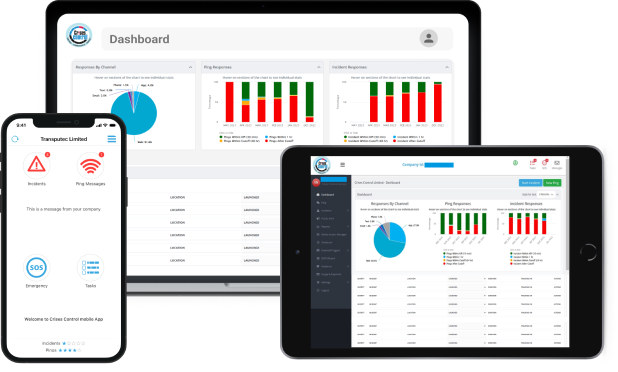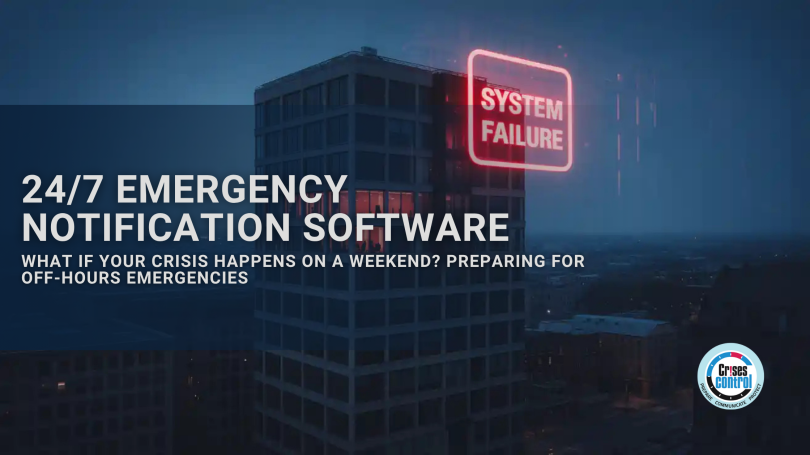Written by Asipe Nokenke | Marketing Assistant
24/7 Emergency Notification Software: The difference between control and chaos when no one is in the office
24/7 emergency notification software is the system that makes sure your organisation doesn’t fall apart when a crisis hits outside of working hours. Think Saturday afternoon, 3 am on a weekday, or during a public holiday when no one is on-site and your senior team is scattered.
That’s when most systems fail, not because of the crisis itself, but because the right people don’t find out in time. Or the alert doesn’t reach the person who can act. Or worse, it gets buried in a crowded inbox and isn’t seen until Monday morning.
Most businesses are not short on continuity plans. They’re short on execution when it counts. That’s the problem. The solution is technology that alerts the right people, automatically escalates when there’s no response, and gives you full visibility even if your entire office is asleep.
The risk of weekend and after-hours emergencies
You might think your business is prepared. But ask yourself this: if a major incident occurred this Friday at 8 pm, would your team know what to do?
Without a proper system in place, the likely answer is no. After-hours response failures happen because:
-
- There’s no automatic alerting from systems or sensors
-
- Only one person gets the alert, and they’re unavailable
-
- No one tracks who responded or what was done
-
- Internal updates take hours instead of minutes
-
- Customers are left in the dark, damaging your brand
Whether it’s a cyberattack, a fire, a data breach, or a supply chain disruption, incidents that happen on weekends have more time to spread. Every hour without action adds to the damage. That’s exactly what 24/7 emergency notification software is designed to prevent.
Why emails and WhatsApp won’t cut it
Some teams still rely on shared spreadsheets, group chats, or email distribution lists to share emergency messages. It’s understandable. These tools are familiar. But they’re not reliable when time is tight.
WhatsApp is great for catching up with colleagues. It’s not built for crisis coordination.
Email doesn’t guarantee delivery or a timely response. It certainly doesn’t track who opened the message or took action. That lack of visibility is dangerous.
In contrast, Crises Control’s notification system allows you to:
-
- Send critical alerts across multiple channels at once (SMS, voice, push, email)
-
- Set up auto-escalation if no response is received
-
- Track who’s received and acknowledged messages in real time
-
- Trigger predefined workflows that assign tasks to the right people
That’s the difference between hoping for a response and knowing it’s in progress.
What makes 24/7 Emergency Notification Software different
A modern emergency communication system like Crises Control is built for reliability, speed, and control. It replaces manual communication processes with a smart, automated approach to incident response.
-
- Multi-channel delivery: One message is sent to multiple platforms at once. If someone misses a call, they’ll get an SMS. If they’re offline, they’ll get an email. The system doesn’t assume your staff are at their desks or checking one specific platform.
-
- Role-based messaging: Instead of sending the same message to everyone, Crises Control sends the right message to the right people, based on role, location, or responsibility. It cuts through the noise and helps people act faster.
-
- Escalation if no response: If someone doesn’t respond in time, the alert automatically escalates to the next person in the chain. This ensures no incident is left unacknowledged.
-
- Integrated incident management: It’s not just messaging. Crises Control allows you to assign tasks, track completion, and manage incident timelines all from your mobile.
Interested in our Ping Mass Notification Platform?
Efficiently alert everyone in seconds at scale with our Mass Notification Platform – PING, get the message out fast and ensure rapid response and recovery.

A weekend incident scenario: What happens with and without software
Let’s imagine two different versions of the same incident.
Scenario: Ransomware attack on Saturday night
Without emergency software:
-
- The alert goes to one IT contact who is on holiday
-
- No one checks the inbox until Sunday evening
-
- Systems are already encrypted and locked
-
- The PR team is unaware until customers start posting on social media
-
- Investigation begins too late, leading to regulatory penalties
With Crises Control:
-
- Monitoring tool detects suspicious activity
-
- Incident automatically triggers an alert to IT, security, and leadership teams
-
- No response in 10 minutes? System escalates to backups
-
- The response workflow is launched, with clear next steps and team roles
-
- Updates are sent to key stakeholders every 30 minutes
By Monday morning, the situation is under control, not just discovered.
How to respond to a business emergency outside office hours
You’ve left the building. Everyone has. But your systems haven’t.
Crises don’t follow your company’s office hours. That’s why your response can’t either. The best way to respond to a business emergency outside office hours is to take people out of the detection phase entirely. Let your systems detect, escalate, and activate response workflows on their own, then bring in people when they’re needed, not after it’s too late.
This means:
-
- Your monitoring systems trigger incidents automatically
-
- The right people are notified immediately, no matter where they are
-
- Those people know exactly what to do because the plan is preloaded
-
- Leadership has visibility into response status at every stage
-
- That’s not a reaction. That’s control.
What to look for in an always-on Crisis Response Platform
When choosing a crisis response platform, not all systems are equal. If you need something that works 24/7, including holidays and weekends, make sure your platform has:
-
- Real-time delivery and acknowledgement tracking
-
- Automated escalation and response triggers
-
- Role-based messaging and custom templates
-
- Incident management tools integrated with your alerts
-
- Cloud and mobile accessibility
-
- Multi-language and time-zone support
-
- Full reporting and audit trails
Crises Control meets all these requirements and is trusted across industries including finance, healthcare, education, logistics, and government.
What you can avoid with the right Emergency Notification System
One of the most common failures during out-of-hours incidents is the delay in detection and response. When a problem occurs, whether it’s a power failure, cyber incident, or safety alert, time is everything. Without a system in place to alert the right people and escalate automatically, hours can be lost. That often means:
-
- Extended downtime and lost revenue
-
- Missed customer or regulatory deadlines
-
- Operational backlogs that take days to recover
-
- Avoidable risk to people, assets, or reputation
With a platform like Crises Control, these risks can be significantly reduced. Alerts can be triggered automatically by monitoring systems or sensors, sent to pre-defined roles, and escalated if no response is received, all without manual input. This empowers your business to transition from detection to resolution in minutes, not hours, even if the crisis hits at 2 am on a public holiday.
Why this matters more now than ever
As operations stretch across time zones and staff work remotely, the traditional 9 to 5 model is gone. You don’t have the luxury of assuming someone will pick things up later. Customers expect 24/7 service, and regulators demand prompt reporting. The financial stakes have never been higher, with the average cost of a data breach climbing to $4.45 million. Crucially, the ability to respond instantly with automated tools provides a powerful defense, allowing businesses to save an average of $1.76 million compared to those without. Crises move fast, and with numbers like these, you can’t afford to be slow.
Conclusion: Be Ready When No One Is Watching
The reality of modern business is that your biggest risks don’t keep office hours. A crisis at 3 am on a Sunday can do more damage than one on a Tuesday morning, simply because of a delayed response. As we’ve shown, the critical failure point isn’t the plan, but its execution when the office is empty.
This is the gap that 24/7 emergency notification software is built to close. It replaces uncertainty with automation, ensuring incidents are detected, escalated, and managed with speed and precision, no matter the time or day. It’s the confidence of knowing that your business is protected around the clock.
Ready to transform your response from reactive to resilient?
Book your free demo today and see how you can prepare your business for any after-hours emergency.
Request a FREE Demo

